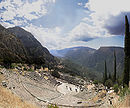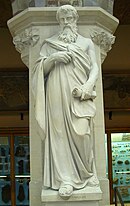Portal:Greece/Selected article
| This Wikipedia page has been superseded by historical reference. |
| Note: Article entries are now being transcluded directly on the main portal page. However, this page should be retained for historical reference. |
Selected article 1
Portal:Greece/Selected article/1
The
Jupiter (Zeus) had formerly existed. They were built around 500 yards south of the much older baths of Achilles of the earlier Greek Acropolis in Byzantion. The baths were famed primarily for the many statues that were built within, and the famous people they each represented. However, they were later used for military purposes, during the seventh century. Excavations of the site and the Baths were made in 1928. Read more...
Selected article 2
Portal:Greece/Selected article/2
Epikleros (ἐπίκληρος) (plural epikleroi) was the name given to an heiress in ancient Athens, and in other ancient Greek city states. It denoted a daughter of a man who had no male heirs. In Sparta they were called patroiouchoi (πατρούχοι), as they were in Gortyn. Athenian women were not allowed to hold property in their own name, so laws to regulate the marriages of epikleroi had to be introduced. Athenian epikleroi were required to marry the nearest male relative of their father, in order to keep their father's property in the family. Even if a woman was already married, evidence suggests that she would have been required to divorce her spouse to marry that relative. Spartan women were allowed to hold property in their own right, and so Spartan heiresses were subject to less restrictive rules. Evidence from other city-states is more fragmentary, only allowing a few observations to be made for Gortyn and Rhegium. Read more...
Selected article 3
Selected article 4
Portal:Greece/Selected article/4
The
Eastern Roman Empire by Constantine the Great. With numerous additions and modifications during their history, they were the last great fortification
system of Antiquity, and one of the most complex and elaborate systems ever built.
Initially built by Constantine the Great, the walls surrounded the new city on all sides, protecting it against attack from both sea and land. As the city grew, the famous double line of the Theodosian Walls was built in the 5th century. Although the other sections of the walls were less elaborate, when well manned, they were almost impregnable for any medieval besieger, saving the city, and the Sieges of Constantinople). Read more...
Selected article 5
Portal:Greece/Selected article/5
The
Greek myths, contributed to turmoil in Egypt, and influenced many of the biblical Exodus stories. Read more...
Selected article 6
Selected article 7
Selected article 8
Portal:Greece/Selected article/8
Merope and was blinded by her father, Oenopion, the recovery of his sight at Lemnos, his hunting with Artemis on Crete, his death by the blow of Artemis or of the giant scorpion which became Scorpio, and his elevation to the heavens. Most ancient sources omit some of these episodes and several tell only one. These various incidents may originally have been independent, unrelated stories and it is impossible to tell whether omissions are simple brevity or represent a real disagreement. Read more...
Selected article 9
Portal:Greece/Selected article/9
The
Crusader armies assembled at Constantinople and promised to return to the Byzantine Empire any land they might conquer. However, Bohemond, the son of Alexios' former enemy Robert Guiscard, claimed the Principality of Antioch
for himself. Alexios did not recognize the legitimacy of the Principality, and Bohemond went to Europe looking for reinforcements. He launched into open warfare against Alexios, but he was soon forced to surrender and negotiate with Alexios at the imperial camp at Diabolis (Devol), where the Treaty was signed.
Under the terms of the Treaty, Bohemond agreed to become a vassal of the Emperor and to defend the Empire whenever needed. He also accepted the appointment of a sebastos and doux (duke) of Antioch, and he was guaranteed the right to pass on to his heirs the County of Edessa. Following this, Bohemond retreated to Apulia and died there. His nephew, Tancred, who was regent in Antioch, refused to accept the terms of the Treaty. Antioch came temporarily under Byzantine sway in 1137, but it was not until 1158 that it truly became a Byzantine vassal. Read more...
Selected article 10
Portal:Greece/Selected article/10
The
Constantine's transferring the capital from Nicomedia in Anatolia to Byzantium, which was renamed Constantinople, on the Bosphorus. Read more...
Selected article 11
Portal:Greece/Selected article/11
The
Gythium, and soon invested and besieged Sparta itself. Eventually, negotiations led to peace on Rome's terms, under which Argos and the coastal towns of Laconia were freed from Spartan rule and the Spartans were compelled to pay a war indemnity to Rome over the next eight years. Argos joined the Achaean League, and the Laconian towns were placed under Achaean protection. Read more...
Selected article 12
Portal:Greece/Selected article/12
The
Julian. Read more...
Selected article 13
Portal:Greece/Selected article/13
Delphi (Greek Δελφοί, [ðe̞lˈfi]) (pronounce and dialectal forms) is an archaeological site and a modern town in Greece on the south-western spur of Mount Parnassus in the valley of Phocis. Delphi was the site of the Delphic oracle, the most important oracle in the classical Greek world, and it was a major site for the worship of the god Apollo. His sacred precinct in Delphi was a Panhellenic sanctuary, where every four years athletes from all over the Greek world competed in the Pythian Games, the precursor to the Olympic Games.
Delphi was revered throughout the Greek world as the site of the omphalos stone, the centre of the earth and the universe. In the inner hestia ("hearth") of the Temple of Apollo, an eternal flame burned. After the battle of Plataea, the Greek cities extinguished their fires and brought new fire from the hearth of Greece, at Delphi; in the foundation stories of several Greek colonies, the founding colonists were first dedicated at Delphi. Read more...
Selected article 14
Portal:Greece/Selected article/14
The
lover, a myth linked to the later fall of the house of Atreus and the sufferings of Oedipus. Read more...
Selected article 15
Portal:Greece/Selected article/15
Soviet war in Afghanistan, during which the site was looted and used as a battleground, leaving very little of the original material. Read more...
Selected article 16
Portal:Greece/Selected article/16
plane geometry, still taught in secondary school as the first axiomatic system and the first examples of formal proof. The Elements goes on to the solid geometry of three dimensions, and Euclidean geometry was subsequently extended to any finite number of dimensions. Much of the Elements states results of what is now called number theory, proved using geometrical methods. Read more...
Selected article 17
Portal:Greece/Selected article/17
self-governed monastic state within the sovereignty of the Hellenic Republic. Spiritually, Mount Athos comes under the direct jurisdiction of the Ecumenical Patriarchate of Constantinople
.
The peninsula, the easternmost "leg" of the larger Chalcidice peninsula, protrudes into the Aegean Sea for some 60 kilometres (37 mi) at a width between 7 to 12 km and covers an area of 335.637 square kilometres (129.59 sq mi), with the actual Mount Athos and its steep, densely forested slopes reaching up to 2,033 metres (6,670 ft). The seas around the end of the peninsula can be dangerous. Read more...
Selected article 18
Portal:Greece/Selected article/18
Black-figure vase painting within a few decades. Its modern name is based on the figural depictions in red colour on a black background, in contrast to the preceding black-figure style with black figures on a red background. The most important areas of production, apart from Attica, were in Southern Italy. The style was also adopted in other parts of Greece. Etruria became an important centre of production outside the Greek World. Attic red-figure vases were exported throughout Greece and beyond. For a long time, they dominated the market for fine ceramics. Only few centres of pottery production could compete with Athens in terms of innovativeness, quality and production capacity. Of the red figure vases produced in Athens alone, more than 40,000 specimens and fragments survive today. Read more...
Selected article 19
Portal:Greece/Selected article/19
Read more...
Selected article 20
Portal:Greece/Selected article/20
The
dialectical method often involves an oppositional discussion in which the defense of one point of view is pitted against another; one participant may lead another to contradict himself in some way, strengthening the inquirer's own point. Socrates began to engage in such discussions with his fellow Athenians after his friend from youth, Chaerephon, visited the Oracle of Delphi, which confirmed Socrates to be the wisest man in Athens. Socrates saw this as a paradox, and began utilizing the Socratic method in order to answer his conundrum. Diogenes Laertius, however, wrote that Protagoras invented the “Socratic” method. Read more...















